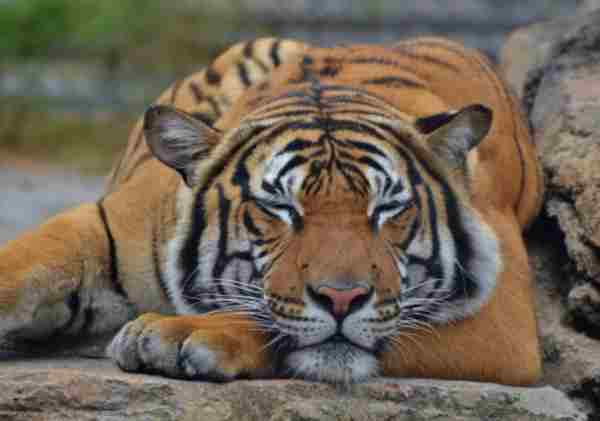Tiger vs. jaguar are both iconic wild cats that are known for their striking patterns and majestic presence. While they may seem similar at first glance, there are actually many differences that distinguish these two magnificent animals. In this blog post, we will delve into the physical characteristics, habitats, diet preferences, and hunting behaviours of tigers and jaguars.
Table of Contents
Whether you’re a seasoned nature enthusiast or simply curious about the differences between warm-blooded animals, this post will provide detailed information to satisfy your curiosity. With our help, you’ll be able to easily distinguish between these two fascinating creatures and gain a deeper appreciation for the diverse wildlife that shares our planet.
Comparison Table: Tiger vs. Jaguar
| Jaguar | Tiger | |
| Scientific name | Panthera onca | Panthera tigris |
| Habitat | Dry deciduous forests, scrublands, savannas, and swamps of central and south America | Tropical forests, grasslands, and swamps of Asia. |
| Diet | Carnivorous predators primarily hunt large mammals | Dry deciduous forests, scrublands, savannas, and swamps of Central and South America |
| Endangered Status | Conservation efforts are ongoing throughout Latin America, where jaguar populations face threats from poaching, habitat destruction, or fragmentation due to agricultural expansionism. | Vulnerable, with a decreasing population due to habitat loss and poaching. |
Tiger:

Undoubtedly, tigers are among the most magnificent creatures on earth, captivating humans with their awe-inspiring beauty and strength. Recognized as the largest members of the cat family, tigers are distinguished by their stunning fur coats consisting of orange with black stripes, each individual having a unique pattern.
With their muscular build, sharp claws, and powerful jaws, tigers are known to be exceptional hunters, preying on all sorts of animals including deer, wild boar, and even elephants and crocodiles. Moreover, their solitary behaviour and elusive nature make them mysterious animals, adding to their allure.
Physical Characteristics
Tigers are known for their stunning appearance and impressive hunting abilities. Their distinctive stripe pattern not only makes them visually striking but also serves a vital purpose in the wild.
By blending into their surroundings, tigers can easily remain camouflaged when hunting, allowing them to approach their prey undetected. Additionally, tigers are not only visually impressive but also physically powerful, with muscular bodies that can weigh up to 400 pounds. Their strong legs and sharp claws are essential for protecting themselves from potential predators.
Habitat and Distribution
These apex predators are native to Asia, with their habitat ranging from tropical forests and grasslands to swamps. However, due to deforestation and human encroachment, their population has dwindled alarmingly.
It is a sad reality that these once widely-distributed predators are now considered endangered, and their survival is in jeopardy. The current population of tigers in the wild is just a few thousand, and immediate action is needed to protect these magnificent creatures.
Diet and Hunting Habits
The tiger, with its powerful muscles and hunting prowess, is a true carnivore that feeds on a variety of large mammals. From deer and boars to buffalo, this predator follows its prey with stealth and patience, waiting for the opportune moment to strike.
Interestingly, tigers are solitary hunters and rely on their physical capabilities to take down animals many times their size. With such impressive hunting skills and a natural inclination towards the carnivorous lifestyle, tigers are truly a force to be reckoned with in the wild.
Social Structure and Breeding Habits
Tigers have a reputation for being solitary animals, but they are not completely immune to the occasional social attachment. Male tigers carve out their own territory and allow multiple female tigers to enter their environment for the purpose of breeding.
When it comes to their newborn cubs, however, tigers are fiercely protective. Tiger cubs are extremely vulnerable in the first few months of their life and remain hidden with their mother to avoid being preyed upon by other animals.
Interaction With Humans
The interaction of tigers with humans is a global issue that requires attention. As the human population grows, the natural habitats of these magnificent creatures are decreasing. This loss of habitat, coupled with the threat of poaching, has brought tigers to the brink of extinction.
Tigers are now listed as an endangered species, and it is our responsibility to ensure their survival. Conservation efforts, such as anti-poaching initiatives and breeding programs, are underway to protect these majestic animals.
It is essential that we recognize the importance of these endangered animals and the need to protect them. Tigers are not just magical creatures, but they hold great value and contribute significantly to the ecosystem.
Jaguars

Physical Characteristics
The jaguar is a remarkable feline predator that is native to the Americas. It is the third-largest big cat and can weigh up to a staggering 250 pounds, making it one of the most robust predators in the animal kingdom.
Jaguars stand out for their appearance, with golden yellow fur accentuated by the distinctive black rosette patterns that adorn their coats. They have well-built muscular limbs, short legs, stocky bodies, and long tails which allow them to traverse various terrains efficiently.
Their strength and speed make them expert ambush predators, and they are well known for their hunting prowess.
Habitat and Distribution
Due to their adaptability, they can be found in a range of habitats, from tropical rainforests to grasslands. Jaguars have a preference for living near water sources, like rivers and streams, which is why they can often be spotted along these areas.
These majestic creatures range in size, with some individuals weighing up to 350 pounds. It’s truly awe-inspiring to see these big cats in the wild, and knowing that they can be found from the southwestern United States to northern Argentina only adds to their allure.
Diet and Hunting Habits
Jaguars are fascinating carnivorous mammals that possess a powerful set of jaws and unique hunting techniques. Their diet mainly includes fish, reptiles, birds, amphibians, as well as small mammals like monkeys and deer. Being solitary hunters, jaguars tend to ambush their prey from the trees or through dense vegetation.
What’s interesting about these big cats is their ability to take down larger prey such as deer, peccaries, and capybaras. However, jaguars can also become a nuisance to humans when they raid livestock, which can lead to conflicts. Nevertheless, these magnificent animals are essential to the ecosystems they inhabit, and it’s crucial for us to work towards their conservation.
Social Structure and Breeding Habits
Jaguars are fascinating creatures that tend to live solitary lives, particularly outside of the breeding season. While male jaguars are typically solitary animals, they may occasionally form temporary associations with other individuals before returning to their reclusive ways.
On the other hand, female jaguars may sometimes stay together in groups composed of related individuals, although this behaviour is less common than that displayed by males within populations. It’s worth noting that jaguar cubs achieve sexual maturity around three years old and usually only give birth once every two to three years, making their reproductive success a crucial aspect of their survival in the wild.
Interaction with Humans
Despite their solitary behaviour, jaguars have historically held a significant role in ancient societies within their range. Particularly prominent among Mayan cultures, they were highly esteemed for their attractive appearance, immense strength, formidable power, and exceptional hunting abilities.
In present times, encounters between humans and jaguars primarily arise as a result of direct competition for resources. This competition typically revolves around necessities such as food and habitat, although it seldom leads to physical conflicts between the two species.
Ongoing conservation initiatives are being carried out across Latin America to address these issues. Jaguar populations are confronted with various threats including poaching, the destruction of their habitats, and the fragmentation caused by the expansion of agriculture.
These conservation efforts are expected to eventually bolster the jaguar populations throughout the continent, yielding benefits for both humans and wildlife alike.
Key Points on Tiger vs. Jaguar
- Tigers possess a unique pattern of stripes, enabling them to seamlessly blend into their environment and maintain camouflage during their hunting endeavours.
- Among the various big cat species, jaguars rank third in terms of size, following tigers and lions. Occasionally, jaguars can reach weights of up to 250 lbs.
- Both jaguars and tigers are carnivorous mammals, primarily relying on a diet consisting of fish, such as piranhas, reptiles like lizards or turtles, birds such as turkeys, amphibians like frogs, and small mammals including monkeys and deer.
- The expansion of the human population has resulted in the depletion of natural habitats for both jaguars and tigers and the persistent threat of poaching continues to jeopardize their survival.
- Tigers, in particular, are recognized for their distinctive stripe pattern, aiding them in seamlessly blending into their surroundings and remaining camouflaged while engaging in hunting activities.
FAQs on Tiger vs. Jaguar
Which is more powerful tiger vs. jaguar?
When it comes to deciding which one is more powerful, however, there are several factors to consider. Tigers are larger and heavier than jaguars, which gives them an advantage in terms of sheer strength and intimidating presence. Jaguars, on the other hand, are known for being faster and more agile, which can make them more effective hunters. Ultimately, it’s difficult to say which of these fearsome felines is truly more powerful. Both have their unique strengths and weaknesses that make them formidable predators in their own right.
Can a jaguar beat a lion or a tiger?
The jaguar, known for its powerful bite and muscular build, is often compared to its larger feline counterparts, the lion and the tiger. While each animal has its unique strengths, the jaguar’s agility and strength make it a formidable opponent.
In fact, jaguars have been known to take down prey much larger than themselves, including caimans and anacondas. When it comes to a one-on-one fight, the jaguar’s techniques for attacking and defending itself could potentially give it an advantage over a lion or tiger.
Do jaguars bite stronger than tigers?
Though both jaguars and tigers have incredibly powerful jaws that can deliver a devastating bite, research has shown that jaguars may actually have a stronger bite force than their striped counterparts. This is due in part to their shorter, more powerful jaws, which allow them to deliver a deeper, more forceful bite.
Final Words on Tiger vs. Jaguar
The tiger and jaguar are two of the most fascinating and awe-inspiring animals on the planet. These creatures are known for their remarkable strength and power, as well as their distinct appearance, behaviour, and range differences. Perhaps the most notable difference between the two is their habitat: while tigers are primarily found in Asia, jaguars are found in Central and South America.
Unfortunately, both species are facing serious threats to their survival, including habitat loss and poaching. The tiger is currently classified as endangered, while the jaguar is considered near threatened. It is essential that we work to protect these animals and their habitats, as they play vital roles in their respective ecosystems.
Reference:
- https://storyteller.travel/jaguar-vs-tiger/
- https://reidparkzoo.org/blog/jaguar-jaw-muscles/
- https://news.cgtn.com/news/2022-02-01/More-About-Tiger-Why-is-the-tiger-the-true-king-of-the-jungle–17iwKbWin1S/index.htm

Jeevan Kodiyan
An animal enthusiast with an interest in zoology, studying the behavior and activities of animals in the wild habitat. I work on research projects related to species conservation and endangered species protection. I also leverage zoology to become an educator, educating others about the importance of protecting our natural environment and the beauty of animals in their natural habitats.









